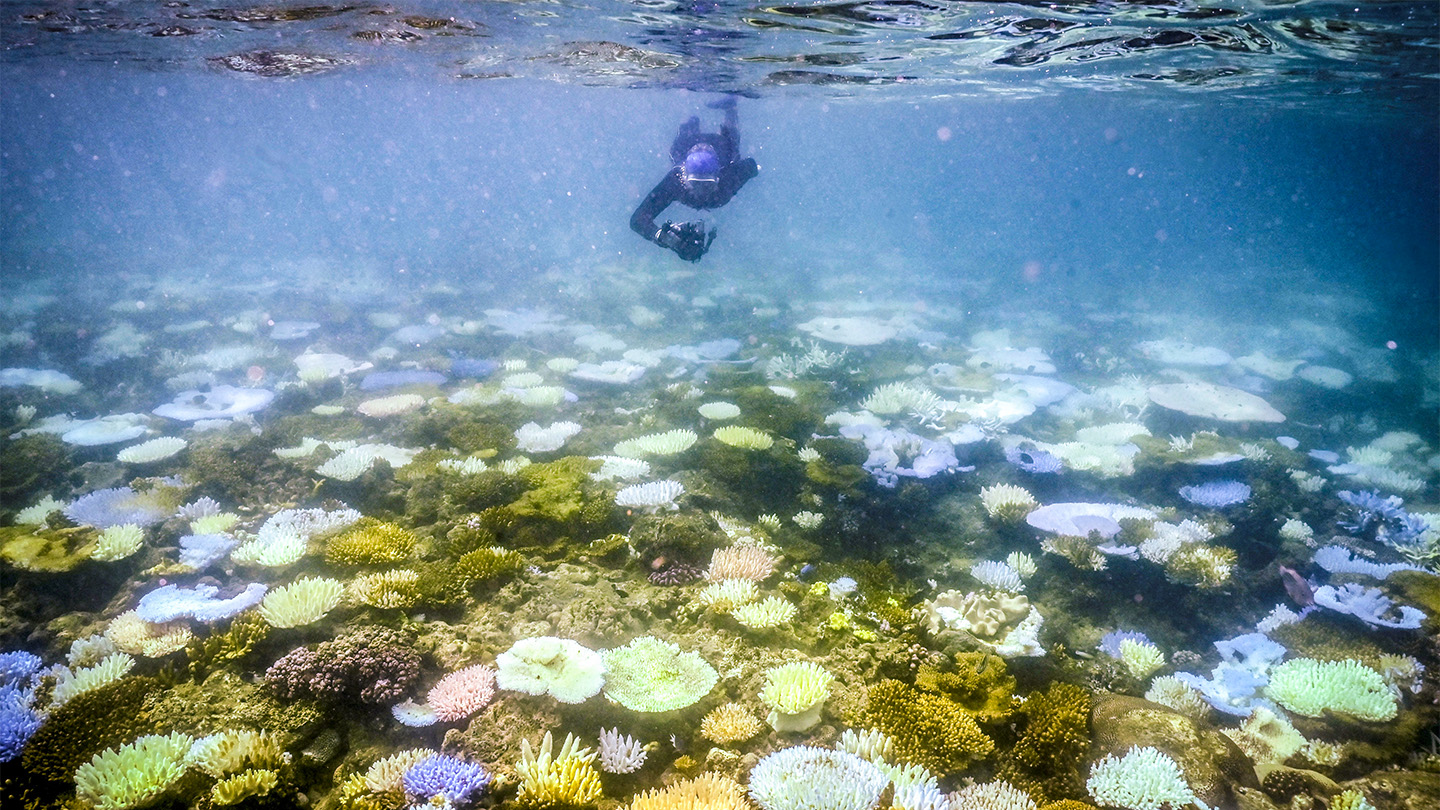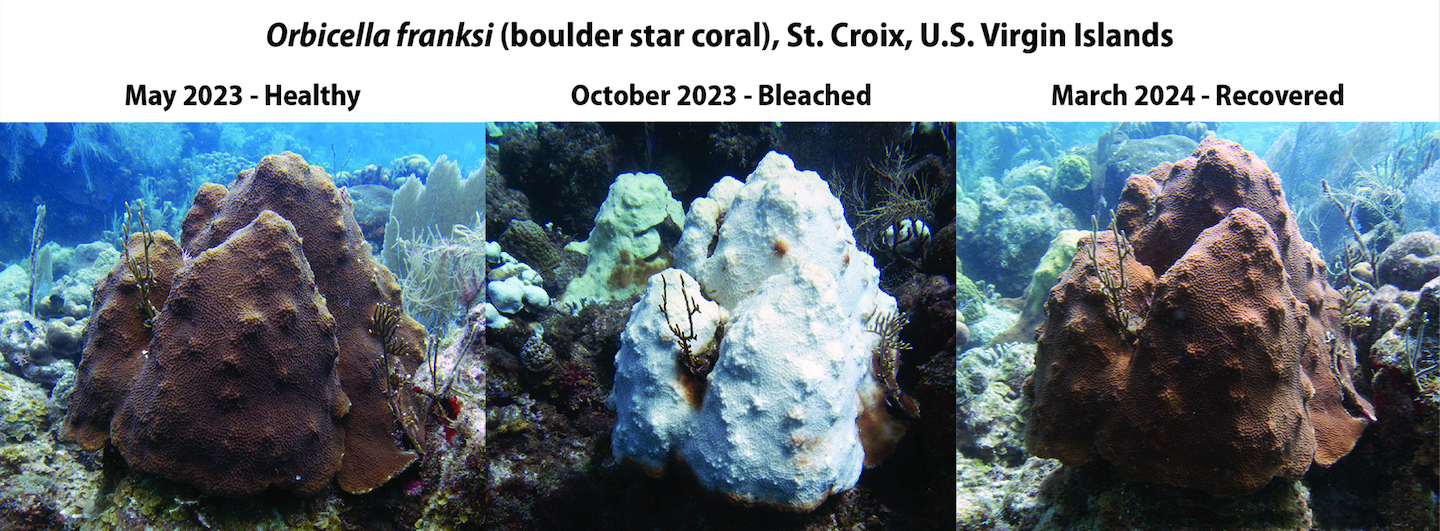The seas’ record-breaking hot streak may bring unwelcome changes
Off-the-charts warming could lead to more coral bleaching, sea-ice melting and hurricanes

Bleached corals (white spots) liberally dotted this portion of Australia’s Great Barrier Reef on April 5, 2024.
David Gray/AFP/Getty Images
Earth’s largest ecosystem is getting cooked. Every day for the last 13 months, average temps over most of the sea’s surface have been the highest for that date in recorded history.
That’s according to data gleaned by the National Oceanic and Atmospheric Administration, or NOAA. Last year, scientists described the early stages of this as the first time Earth’s oceans became “hot-tub” hot.
“And we’re currently outpacing last year,” notes Robert West. He’s a meteorologist in Miami, Fla. He works for NOAA. And it’s not over, West adds. “We’re continuing to set records, even now.”
An El Niño has helped heat the seas. This climate event periodically develops when warmth spreads across surface waters in the tropical Pacific. El Niños emerge every few years. The latest started in late spring of 2023.
But natural climate cycles can’t explain all the warming. Heat is being stored within the sea’s top 2 kilometers (1.3 miles). This stored heat has been growing for decades, notes Hosmay Lopez. He’s a NOAA oceanographer who works in Miami. And, he adds, the rate of warming in that upper ocean has been speeding up.
Why? Since 1971, the ocean has absorbed more than 90 percent of the excess heat that greenhouse gases have trapped in Earth’s atmosphere. We’re talking about more than 380 zettajoules of heat. That’s a lot. It’s about 1.5 million times as much energy as was released two years ago during the Hunga Tonga-Hunga Ha’apai volcanic eruption. It’s also some 25 billion times as much energy as was released by the atomic bomb dropped on Hiroshima, Japan, in 1945.
Sending all that heat into the ocean has lots of impacts. Here are a few.
A hyperactive Atlantic hurricane season?
Hurricanes feed on water vapor and heat coming off the ocean. Right now, the Atlantic is very hot. So expect a very active hurricane season.
On April 4, researchers at Colorado State University in Fort Collins released their 2024 outlook. The biggest hurricanes get names. The outlook forecasts 23 named storms for this upcoming season. Five will likely rank as at least a Category 3, it said. Such storms have minimum sustained winds of 179 to 208 kilometers per hour (111 to 129 miles per hour). It also put the chance of a major hurricane hitting the United States at 62 percent.
Researchers at the University of Pennsylvania issued their own outlook three weeks later. It predicts some 33 named storms for this season.
Most hurricanes form in a stretch of the Atlantic between the Caribbean Sea and West Africa. Sea-surface temps in this co-called main development region, or MDR, have been super high. Right now, they’re more than 1.5 degrees Celsius (2.7 degrees Fahrenheit) above normal, NOAA data show.
Since 1981, there have been only 10 months for which the MDR’s surface has been that warm, West says. “Eight of those months — not yet including April 2024 — have occurred in the last year.”
La Niña is the counterpart to an El Niño. It develops where surface waters become relatively cool across much of the tropical Pacific. The likely emergence of a La Niña contributes to the new hurricane forecasts. Why? Winds over the Atlantic tend to tear apart developing hurricanes. These winds weaken during a La Niña. That makes hurricanes more likely to occur.
As of April 11, NOAA reported an 80 percent chance that La Niña will emerge by August to October. That’s peak hurricane season.
“It only takes one hurricane making landfall to make it an active season,” the Colorado State report says.
Do you have a science question? We can help!
Submit your question here, and we might answer it an upcoming issue of Science News Explores
Corals are bleaching globally
Sweltering seas can imperil the world’s corals. These living structures support roughly one-fourth of all known marine species.
When stressed by heat, corals expel the vibrantly colored algae that live in their tissues. These photosynthetic houseguests normally provide them with food. But their departure lays bare the corals’ white skeletons. These are known as bleaching events. And they can be fatal to corals.
Since early 2023, coral bleaching has gone global. In fact, on April 15, NOAA announced that conditions formally qualify as a global coral bleaching event. It’s only the fourth such event since mass bleaching was first observed in the 1980s.

“From February 2023 to April 2024, significant coral bleaching has been documented in both the Northern and Southern hemispheres of each major ocean basin,” noted Derek Manzello. He’s a NOAA coral-reef ecologist who works in College Park, Md.
How many corals die in this event is something we won’t know until months or years after it’s over, says marine ecologist Carly Kenkel. She works at the University of Southern California in Los Angeles. “I can say that this is the worst bleaching that we’ve ever seen for the Caribbean. And it’s certainly looking like that for the Great Barrier Reef [off Australia] as well.”
Antarctic sea ice reaches new lows
The Southern Ocean has absorbed almost as much heat from human-caused climate change as the Atlantic, Pacific and Indian Oceans combined. That’s partly because strong winds circulate over the Southern Ocean. They continuously draw cold, heat-sapping waters to its surface. The result of absorbing all that heat: Over the last year, Antarctic sea ice has fared poorly.
In a typical February, Antarctic sea ice dwindles to a yearly minimum. It had been bottoming out around 3 million square kilometers (1.2 million square miles). That’s according to the National Snow and Ice Data Center. It’s in Boulder, Colo. This past February, that ice retreated even more — to just 2 million square kilometers. That was a tie for the second-lowest annual minimum on record. Just five months before, the yearly maximum ice cover for the year there reached a new record low — some 17 million square kilometers (6.6 million square miles).
Ocean warming and changes in air currents probably drove these lows, says Monica Ionita. “It was too warm above the ice and too warm below,” says this climatologist. She works at the Alfred Wegner Institute Helmholtz Center for Polar and Marine Research. It’s in Bremerhaven, Germany.
Antarctic sea ice had been more or less stable since the 1980s. Around 2015, that all changed.
Suddenly, surface temps in the Southern Ocean began climbing. And now there have been three Antarctic summers during which sea ice hit record lows. Some researchers worry that these low Antarctic sea ice levels are a new normal.
And why do we care? As that ice melts, the extra water has to go somewhere. And that somewhere is eventually onto land, where it can swamp coastal communities across the globe.
The data would seem to indicate that a permanent shrinking in Antarctic sea ice is underway, Ionita says. But to be sure, it would help to have more than 40 years of satellite data on this.
On the other end of the planet, Arctic sea ice had been falling steadily. It had been dropping some 12 percent each decade. But in recent years, this sea ice has not set new record lows. That may be because the Arctic has already settled into its own new norm, Ionita speculates.
If a similar transition is underway in Antarctica, she notes, a decline in sea ice might temporarily stabilize there, too. “We’ll have to see.”
For now, scientists don’t know when sea-surface temperatures will stop breaking records.
A La Niña might help cool the seas’ surface, Lopez says. However, the seas kept breaking temperature records during the La Niña that stretched from 2020 to 2023. What that shows, West says, is that even if Pacific waters near the equator cool, “it doesn’t necessarily mean that you stop breaking records everywhere.”







